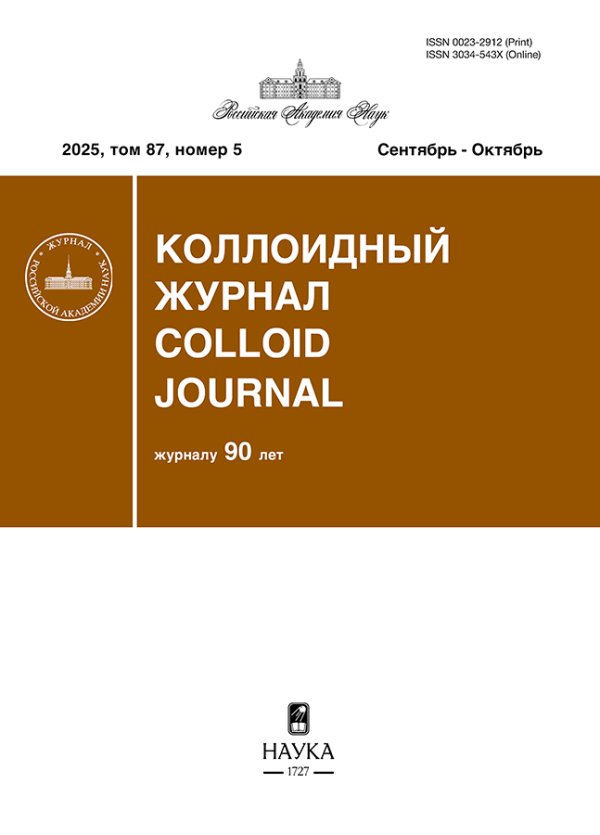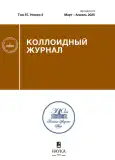Vol 87, No 2 (2025)
- Year: 2025
- Published: 15.03.2025
- Articles: 8
- URL: https://journals.rcsi.science/0023-2912/issue/view/20189
Articles
TEMPERATURE-DEPENDENT WETTABILITY OF CONDUCTIVE FILMS BASED ON ELECTROPHORETIC SILVER NANOPARTICLE CONCENTRATES
Abstract
 89-100
89-100


On the electrostatic interaction of dielectric particles in an electrolyte solution in the strong screening regime
Abstract
 101-108
101-108


Sorption of neutral red dye by entersorbent polysorb MP from AOT microemulsion in n-decan
Abstract
Sorption of the cationic neutral red dye by Polysorb MP from a microemulsion of 0.25 mol/l AOT in n-decane was carried out at different contents of the aqueous pseudophase. The maximum sorption capacity of the sorbent in the microemulsion exceeded the corresponding one in the aqueous phase by an order of magnitude and amounted to 55 mg/g. A sharp drop in the degree of extraction with an increase in the water content of the microemulsion from 1 to 8 volume percent and the reversibility of sorption processes were demonstrated. Anionic dyes were not extracted by Polysorb MP in the same systems. With increasing water content, the zeta potential of SiO2 particles decreased from 18 to 1 mV. Based on the obtained dependencies, a cation exchange mechanism of microemulsion sorption was proposed, including the exchange of sodium and neutral red cations between micelles adsorbed on the surface of particles and micelles in the bulk of the microemulsion.
 109-117
109-117


ON THE CALCULATION OF ELECTROKINETIC POTENTIAL IN DETONATION NANODIAMOND DISPERSIONS
Abstract
The applicability of various approximations of the theory of electrophoresis for calculating the electrokinetic potential in real nanodisperse systems was evaluated on the example of the polydispersed aqueous sol of thermooxidized detonation nanodiamond containing aggregates of nanoparticles, depending on the concentration and pH of background electrolyte solutions (NaCl). It was found that at low potentials ζW < 25 mV calculated for the primary particles in the framework of the Wiersema’s model, taking into account particle aggregation and aggregate porosity practically does not affect the electrokinetic potential. In the range 25–50 mV, the most reliable values of the electrokinetic potentials of aggregates seem to be obtained using the Miller’s equation for ion-conducting particles, taking into account their real porosities providing that the potential is constant. At > 50 mV, knowing the real size of the aggregates, assuming that they are monolithic, the Overbeek’s equation with Oshima’s analytical expressions of the functions f3(κr) and f4(κr) can be used to calculate the electrokinetic potentials.
 118-127
118-127


STUDY OF MECHANISM OF STRUCTURE FORMATION IN AQUEOUS DISPERSIONS OF NA+-SMECTITES
Abstract
Present paper contains the results of an experimental study of the colloidal structures and rheology of aqueous dispersions of Na+-montmorillonite, which were obtained by capillary and rotational viscometry methods. Aqueous dispersions of clay colloids undergo significant structural changes, accompanied by great change in the type of the flow. All these changes are managed by alteration in indifferent electrolyte concentration within a narrow concentration range. Certain critical concentration was found to appear near about 3 mM NaCl concentration for the series of dispersions with 0.25–3.0 wt% solid content. This concentration point is significantly lower than the coagulation thresholds known from the experimental and theoretical works in this field. Existence of such a critical region may reflects both processes of formation/disruption of aggregates and change in the mechanism of either aggregation or structure formation. The obtained rheological data were compared with theoretical calculations and the results of dispersion analysis (by DLS method) of aqueous dispersions which might make a bit development in the field of colloid structure investigation of smectite dispersions.
 128-141
128-141


Collective excitations in amorphous ice
Abstract
 142-148
142-148


Control of self-organization of thiacalix[4]crown-ethers in cone and 1,3-alternate forms in nanofilms on quartz substrate
Abstract
Morphological characteristics of the nanolayers of amphiphilic tert-butylthiacalix[4]crown-4-ether in cone stereoisomeric form 1 and bolaamphiphilic nitrothiacalix[4]biscrown-5-ether in 1,3-alternate form 2 deposited onto quartz substrate at varying solvent, temperature, and concentration of compounds is analyzed. Quantum-chemical calculations of the considered calix[4]arenes reveal a favorable micellar aggregation (the packing factor p < 0.3). During AFM visualization of calixarene nanolayers prepared through evaporation of solvent on substrate, spherical associates that are 200–800 nm in size are detected for compound 1, which enlarge with a decrease in the concentration of compound and an increase in solvent polarity and environmental temperature. At the same time, the dispersity of the sizes of associates increases with a decrease in temperature, but has a mixed dependence on solvent and concentration. The most uniform size distribution of spherical particles is achieved upon Langmuir monolayer formation at the air–water interface upon deposition of the solution of compound 1 in 10–5 M solution in chloroform onto water subphase and upon vertical transfer onto substrate. In the case of bolaamphiphile 2, spherical associates are formed at t = 23°C in 10–5 М solution in toluene and at 4°С in 10–4 М solution in chloroform, while under other combinations of conditions, the nanofilm is represented by thread-like structures (at 23°С) and tactoid aggregates (at 4°С). Dynamic light scattering study of the solutions of amphiphile 1 in chloroform allows to detect spherical aggregates (particle size is 202 ± 92 nm), which indicates the decisive role of solvent in the formation of spherical aggregates in nanolayers, while in other cases the supramolecular organization of calixarenes is presumably affected by the interaction with substrate.
 149-160
149-160


Micellar and antimicrobial properties of a series of bis-quaternary ammonium compounds based on DABCO derivatives
Abstract
 161-170
161-170












